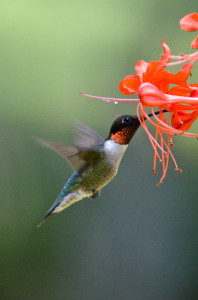By Katrina Marland
Trees need a lot of things to stay healthy. The water, air and soil conditions all need to be right; the temperature can’t go too high or low; and of course, they need sunlight. But there’s something else trees need — something so important that without them, our forests, parks and backyards all across the U.S. would be completely different: pollinators.
The U.S. Fish and Wildlife Service (USFWS) has dubbed this National Pollinators Week. What a great idea! A week to recognize all the creatures that carry pollen among flowering trees and other plants, allowing them to reproduce and maintain genetic diversity. They also make a lot of our food possible, pollinating an estimated 75 percent of our crops, which accounts for billions of dollars each year. So to whom do we owe our health and wealth, natural and otherwise?
- Birds: Our feathered friends help pollinate plants as they feed from the flowers. Hummingbirds are most common type in the U.S. When they put their bill into a flower to eat its nectar, the flower’s pollen rubs off on them. Then they spread that pollen to the next flower they feed from, and so on.
- Bees: Actually, a whole host of insects are responsible for the majority of pollination. Bees are at the head of the pack though, pollinating an estimated 80 percent of crops across the globe, from fruit orchards to vegetable gardens. Beetles, flies, moths, wasps, butterflies and many other species also work to pollinate flowering trees, shrubs, and other plants.
- Bats:There aren’t many mammals in the pollinators club, but several species of bats are among them, including the lesser long-nosed bat and the Mariana fruit bat.
All these creatures keep countless plant species healthy and producing the fruits that many other species depend on. Then, of course, there are the carnivores, which prey on the species that depend on those plants. All of it adds up to the fact that pollinators are an important part in any ecosystem, and a vital link in the food web. Unfortunately, this means that when the pollinators are threatened, it can present a serious challenge to the ecosystem, and put other species in danger. Of all the pollinator species in the U.S., more than 30 are endangered, including several birds, three bats, and more than 25 species of butterflies.
For some species, the threats are obvious. Pesticides are a clear danger, spreading harsh chemicals to the creatures that feed from or make their homes in the sprayed plants. Habitat loss is another major factor. Since many pollinators are migratory, their migration corridors also need to remain healthy in order for them to survive. For some species, that can mean a very large swath of land. The monarch butterfly, for instance, travels the roughly 3,000 miles from Canada to Mexico each year. As patches of its habitat along that path disappear, the journey becomes more and more difficult.
Fortunately, there are several things you can do to help. You can plant a garden of native plants, especially milkweed, to provide a healthy habitat for native pollinators like butterflies and other insects. Staying informed about the pesticides you use is also a good step — especially knowing where and when not to apply them. You can also learn a lot more about pollinators through the materials offered by the USFWS, including podcasts and webcasts. Lastly, you can help support our work. Many of American Forests’ projects each year work to reestablish habitats and migration corridors for wildlife, including pollinators like the Monarch butterfly and ruby-throated hummingbird.

